Joint Study of Impingement Combustion Simulation and Diesel Visualization Experiment of Variable Injection Pressure in Constant Volume Vessel
Abstract
:1. Introduction
2. Experimental and Simulation Setup
2.1. Visualization Experiment Platform and Wall Plate Impingement System
2.2. CFD Simulation Conditions in CONVERGE™
3. Results and Discussion
3.1. Spray Images and Spray Penetration
3.2. Ignition Images and Analysis
3.3. Flame lift-Off Length and Diffusion Area
3.4. Flame Spatially Integrated Natural Luminosity (SINL) and Time Integral Natural Luminosity (TINL)
3.5. Equivalence Ratio and Soot Generation in CFD Combustion Simulation
4. Conclusions
- When the spray penetration does not reach the impinging wall plate, the wall plate still has a restrictive effect on the mixed gas, causing the dense mixture to form in the near-wall area and the local mixing quality to decrease. This phenomenon cannot be detected by using spray imaging.
- The high velocity of the spray under the higher injection pressure could accelerate the mixture of the lower mixing area to the combustion state by entraining more air, enabling the combustion to reach the destination fuel reaction equivalence ratio faster. Additionally, more heat is released from the gas after combustion at the same time under higher IP.
- The higher kinetic energy brought by higher spray velocity makes the gas diffuse in the space more extensively, which can be shown by the evolution of the diffusion flame area and the TINL.
- The changing trends of soot generation under different IP are the same under the experiments and simulations. Compared with 90 MPa, 130 MPa IP reduces the final soot amount in the experiment and simulation by 1.2% and 28%, respectively, because of the rapid combustion. The difference between the experimental results under different injection pressures is smaller than the simulation results because of the superposition of flame luminosity, so the soot formation under higher IP is relatively overpredicted in the experiment.
Author Contributions
Funding
Acknowledgments
Conflicts of Interest
Abbreviations
| DI | direct injection |
| ASOI | after start of injection |
| PM | particulate matter |
| TINL | time integrated natural luminosity |
| SINL | spatially integrated natural luminosity |
| IP | injection pressure |
References
- Matti Maricq, M. Chemical characterization of particulate emissions from diesel engines: A review. J. Aerosol Sci. 2007, 38, 1079–1118. [Google Scholar] [CrossRef]
- Long, C.M.; Nascarella, M.A.; Valberg, P.A. Carbon black vs. black carbon and other airborne materials containing elemental carbon: Physical and chemical distinctions. Environ. Pollut. 2013, 181, 271–286. [Google Scholar] [CrossRef] [PubMed] [Green Version]
- Hiroyasu, H.; Arai, M. Structures of Fuel Sprays in Diesel Engines; SAE Technical Paper 900475; SAE International: Warrendale, PA, USA, 1990. [Google Scholar]
- Tree, D.R.; Svensson, K.I. Soot processes in compression ignition engines. Prog. Energy Combust. Sci. 2007, 33, 272–309. [Google Scholar] [CrossRef]
- Dec, J.E.; Tree, D.R. Diffusion-Flame/Wall Interactions in a Heavy-Duty DI Diesel Engine; SAE Technical Paper 2001-01-1295; SAE International: Warrendale, PA, USA, 2001. [Google Scholar]
- Donkerbroek, A.; Boot, M.; Luijten, C.; Dam, N.N.; Ter Meulen, J. Flame lift-off length and soot production of oxygenated fuels in relation with ignition delay in a DI heavy-duty diesel engine. Combust. Flame 2011, 158, 525–538. [Google Scholar] [CrossRef]
- Mueller, C.J.; Martin, G.C. Effects of Oxygenated Compounds on Combustion and Soot Evolution in a DI Diesel Engine: Broadband Natural Luminosity Imaging; SAE Technical Paper 2002-01-1631; SAE International: Warrendale, PA, USA, 2002. [Google Scholar]
- Karthic, S.; Kumar, M.S.; Nataraj, G.; Pradeep, P. An assessment on injection pressure and timing to reduce emissions on diesel engine powered by renewable fuel. J. Clean. Prod. 2020, 255, 120186. [Google Scholar] [CrossRef]
- Agarwal, A.K.; Srivastava, D.K.; Dhar, A.; Maurya, R.K.; Shukla, P.C.; Singh, A.P. Effect of fuel injection timing and pressure on combustion, emissions and performance characteristics of a single cylinder diesel engine. Fuel 2013, 111, 374–383. [Google Scholar] [CrossRef]
- Zhang, Y.; Jia, M.; Liu, H.; Xie, M. Development of an improved liquid film model for spray/wall interaction under engine-relevant conditions. Int. J. Multiph. Flow 2016, 79, 74–87. [Google Scholar] [CrossRef]
- Jafarmadar, S.; Khalilarya, S.; Shafee, S.; Barzegar, R. Modeling the effect of spray/wall impingement on combustion process and emission of DI diesel engine. Therm. Sci. 2009, 13, 23–33. [Google Scholar] [CrossRef]
- Wang, X.; Huang, Z.; Zhang, W.; Kuti, O.A.; Nishida, K. Effects of ultra-high injection pressure and micro-hole nozzle on flame structure and soot formation of impinging diesel spray. Appl. Energy 2011, 88, 1620–1628. [Google Scholar] [CrossRef]
- Bruneaux, G. Combustion structure of free and wall-impinging diesel jets by simultaneous laser-induced fluorescence of formaldehyde, poly-aromatic hydrocarbons, and hydroxides. Int. J. Engine Res. 2008, 9, 249–265. [Google Scholar] [CrossRef]
- Mohammadi, A.; Kidoguchi, Y.; Miwa, K. Effect of Injection Parameters and Wall-Impingement on Atomization and Gas Entrainment Processes in Diesel Sprays; SAE Technical Paper 2002-01-0497; SAE International: Warrendale, PA, USA, 2002. [Google Scholar]
- Marčič, S.; Marčič, M.; Wensing, M.; Vogel, T.; Praunseis, Z. A simplified model for a diesel spray. Fuel 2018, 222, 485–495. [Google Scholar] [CrossRef]
- Zhang, W.; Nishida, K.; Gao, J.; Miura, D. An experimental study on flat-wall-impinging spray of microhole nozzles under ultra-high injection pressures. Proc. Inst. Mech. Eng. Part D J. Automob. Eng. 2008, 222, 1731–1741. [Google Scholar] [CrossRef]
- Moon, S.; Gao, Y.; Wang, J.; Fezzaa, K.; Tsujimura, T. Near-Field dynamics of high-speed diesel sprays: Effects of orifice inlet geometry and injection pressure. Fuel 2014, 133, 299–309. [Google Scholar] [CrossRef]
- Agarwal, A.K.; Dhar, A.; Gupta, J.G.; Kim, W.I.; Lee, C.S.; Park, S. Effect of fuel injection pressure and injection timing on spray characteristics and particulate size–number distribution in a biodiesel fuelled common rail direct injection diesel engine. Appl. Energy 2014, 130, 212–221. [Google Scholar] [CrossRef]
- Shi, Z.; Lee, C.-F.; Wu, H.; Li, H.; Wu, Y.; Zhang, L.; Bo, Y.; Liu, F. Effect of injection pressure on the impinging spray and ignition characteristics of the heavy-duty diesel engine under low-temperature conditions. Appl. Energy 2020, 262, 114552. [Google Scholar] [CrossRef]
- Chen, P.-C.; Wang, W.-C.; Roberts, W.L.; Fang, T. Spray and atomization of diesel fuel and its alternatives from a single-hole injector using a common rail fuel injection system. Fuel 2013, 103, 850–861. [Google Scholar] [CrossRef]
- Abu-Hamdeh, N.H.; Bantan, R.A.; Alimoradi, A.; Pourhoseini, S. The effect of injection pressure on the thermal performance and emission characteristics of an oil burner operating on B20 palm oil biodiesel-diesel blend fuel. Fuel 2020, 278, 118174. [Google Scholar] [CrossRef]
- Du, W.; Zhang, Q.; Bao, W.; Lou, J. Effects of injection pressure on spray structure after wall impingement. Appl. Therm. Eng. 2018, 129, 1212–1218. [Google Scholar] [CrossRef]
- Kuti, O.A.; Zhu, J.; Nishida, K.; Wang, X.; Huang, Z. Characterization of spray and combustion processes of biodiesel fuel injected by diesel engine common rail system. Fuel 2013, 104, 838–846. [Google Scholar] [CrossRef]
- Zhao, Z.; Zhu, X.; Naber, J.; Lee, S.-Y. Assessment of impinged flame structure in high-pressure direct diesel injection. Int. J. Engine Res. 2020, 21, 391–405. [Google Scholar] [CrossRef]
- Gaydon, A. The Spectroscopy of Flames; Springer Science & Business Media: Berlin, Germany, 2012. [Google Scholar]
- Dec, J.E.; Espey, C. Chemiluminescence Imaging of Autoignition in a DI Diesel Engine; SAE Technical Paper 982685; SAE International: Warrendale, PA, USA, 1998. [Google Scholar]
- Pickett, L.; Siebers, D.; Idicheria, C. Relationship between ignition processes and the lift-off length of diesel fuel jets. SAE Trans. 2005, 114, 1714–1731. [Google Scholar]
- Ma, Y.; Huang, S.; Huang, R.; Zhang, Y.; Xu, S. Ignition and combustion characteristics of n-pentanol–diesel blends in a constant volume chamber. Appl. Energy 2017, 185, 519–530. [Google Scholar] [CrossRef]
- Wu, H.; Nithyanandan, K.; Zhou, N.; Lee, T.H.; Lee, C.-F.F.; Zhang, C. Impacts of acetone on the spray combustion of Acetone-Butanol-Ethanol (ABE)-Diesel blends under low ambient temperature. Fuel 2015, 142, 109–116. [Google Scholar] [CrossRef]
- Yesilyurt, M.K. The effects of the fuel injection pressure on the performance and emission characteristics of a diesel engine fuelled with waste cooking oil biodiesel-diesel blends. Renew. Energy 2019, 132, 649–666. [Google Scholar] [CrossRef]
- Oh, K.C.; Lee, C.B.; Lee, E.J. Characteristics of soot particles formed by diesel pyrolysis. J. Anal. Appl. Pyrolysis 2011, 92, 456–462. [Google Scholar] [CrossRef]
- Jung, Y.; Oh, K.C.; Bae, C.; Shin, H.D. The effect of oxygen enrichment on incipient soot particles in inverse diffusion flames. Fuel 2012, 102, 199–207. [Google Scholar] [CrossRef]
- Desgroux, P.; Mercier, X.; Thomson, K.A. Study of the formation of soot and its precursors in flames using optical diagnostics. Proc. Combust. Inst. 2013, 34, 1713–1738. [Google Scholar] [CrossRef]
- Raj, A.; Yang, S.Y.; Cha, D.K.; Tayouo, R.; Chung, S.H. Structural effects on the oxidation of soot particles by O2: Experimental and theoretical study. Combust. Flame 2013, 160, 1812–1826. [Google Scholar] [CrossRef]
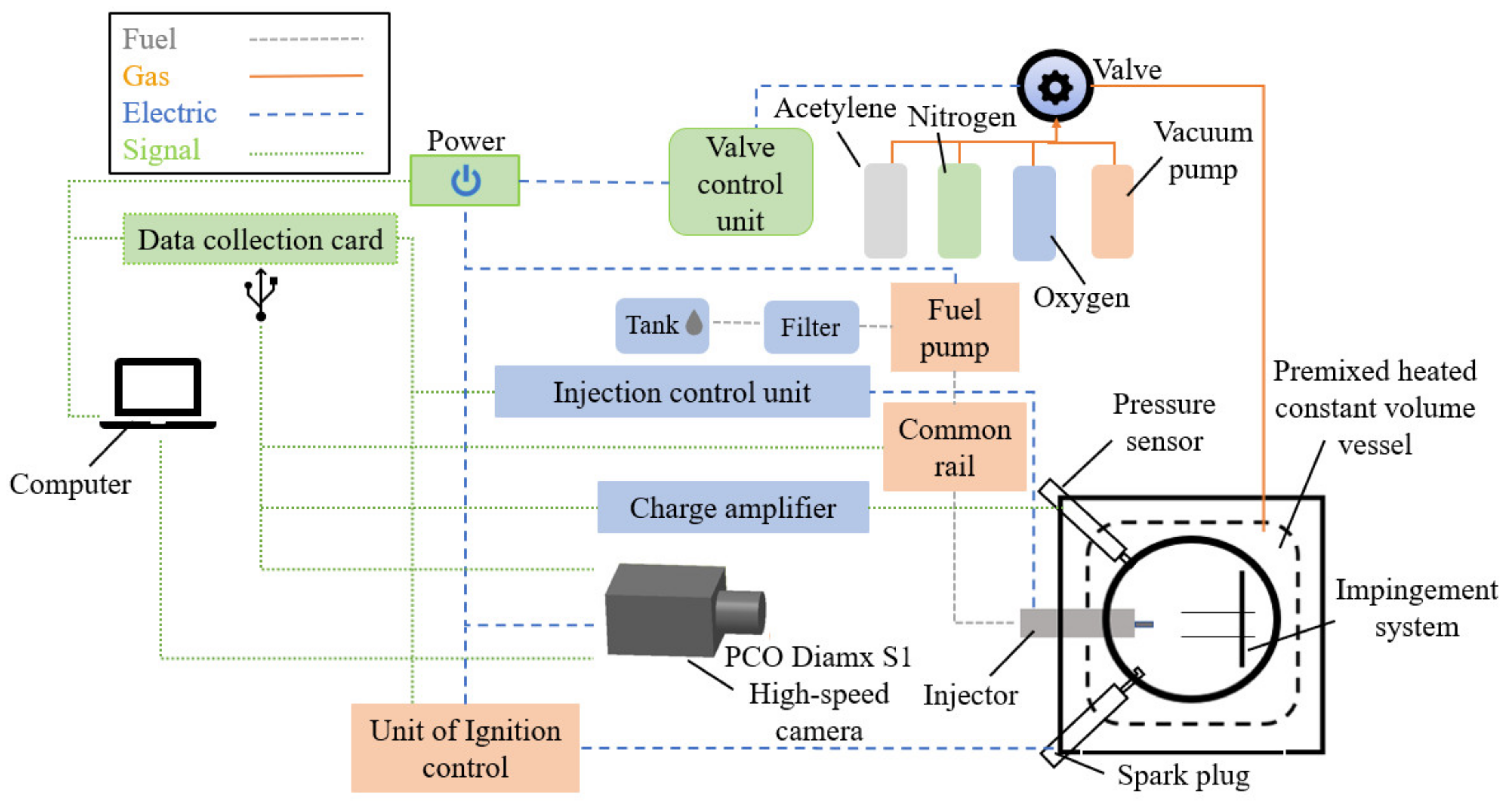

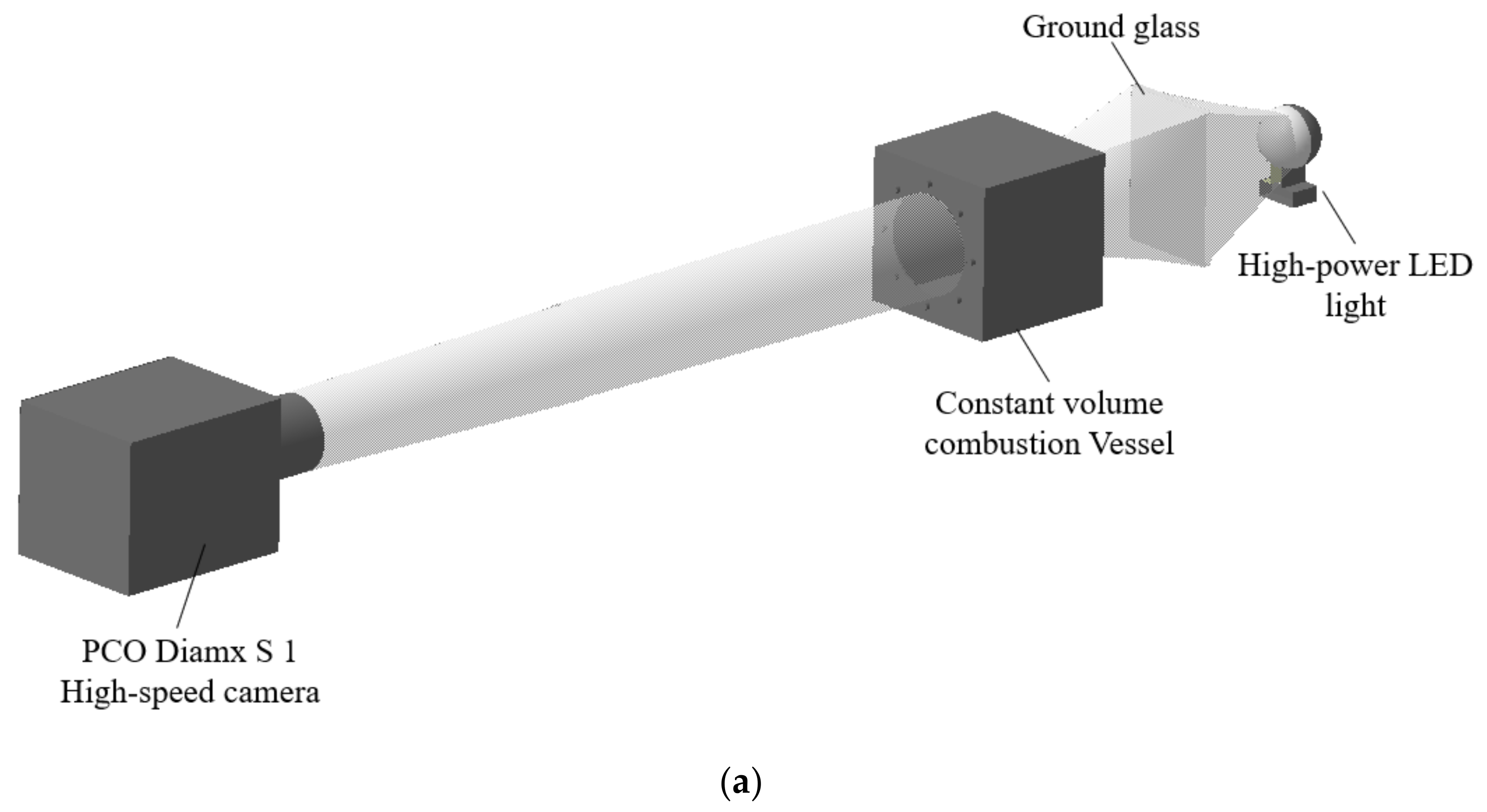


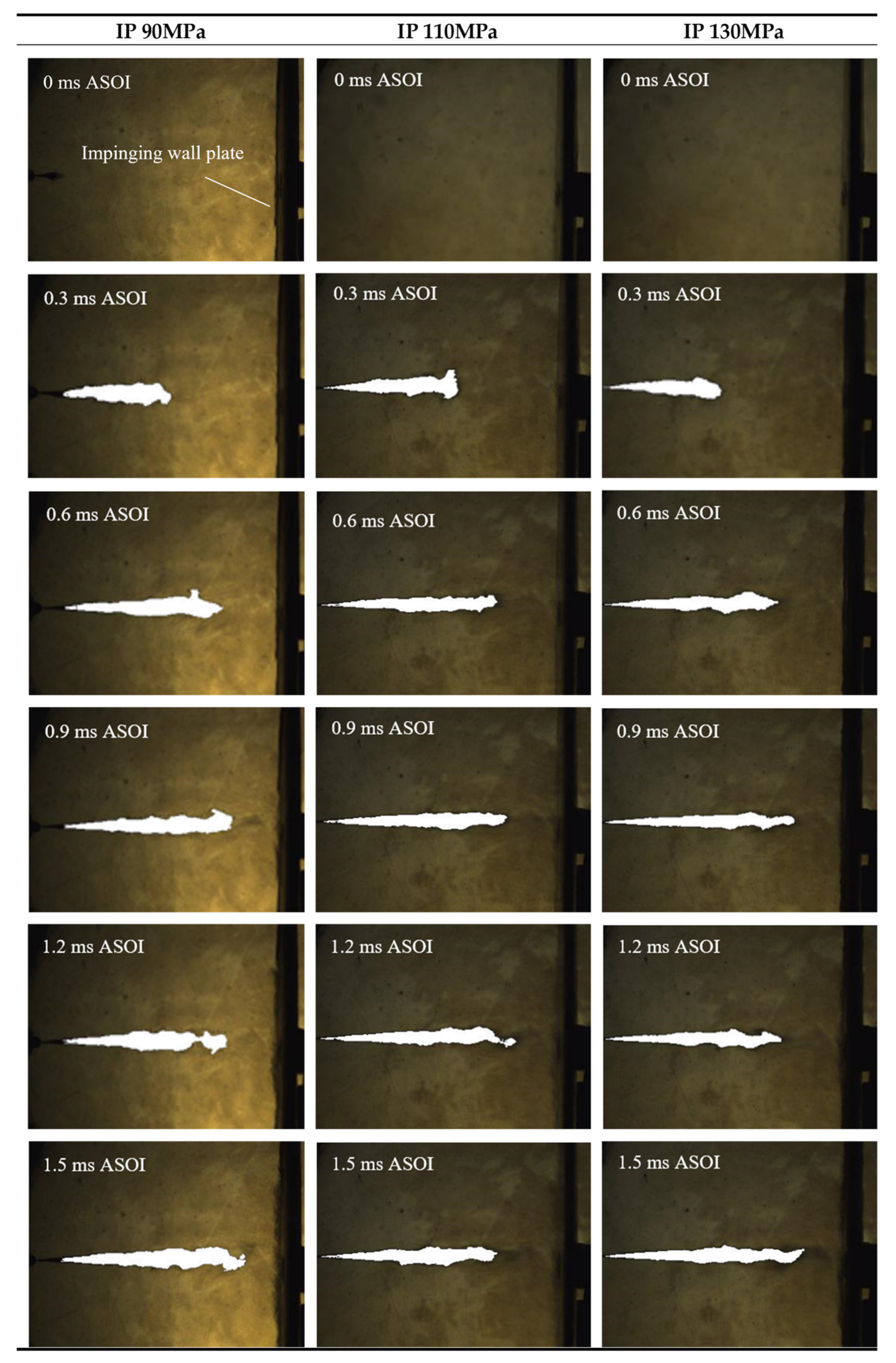
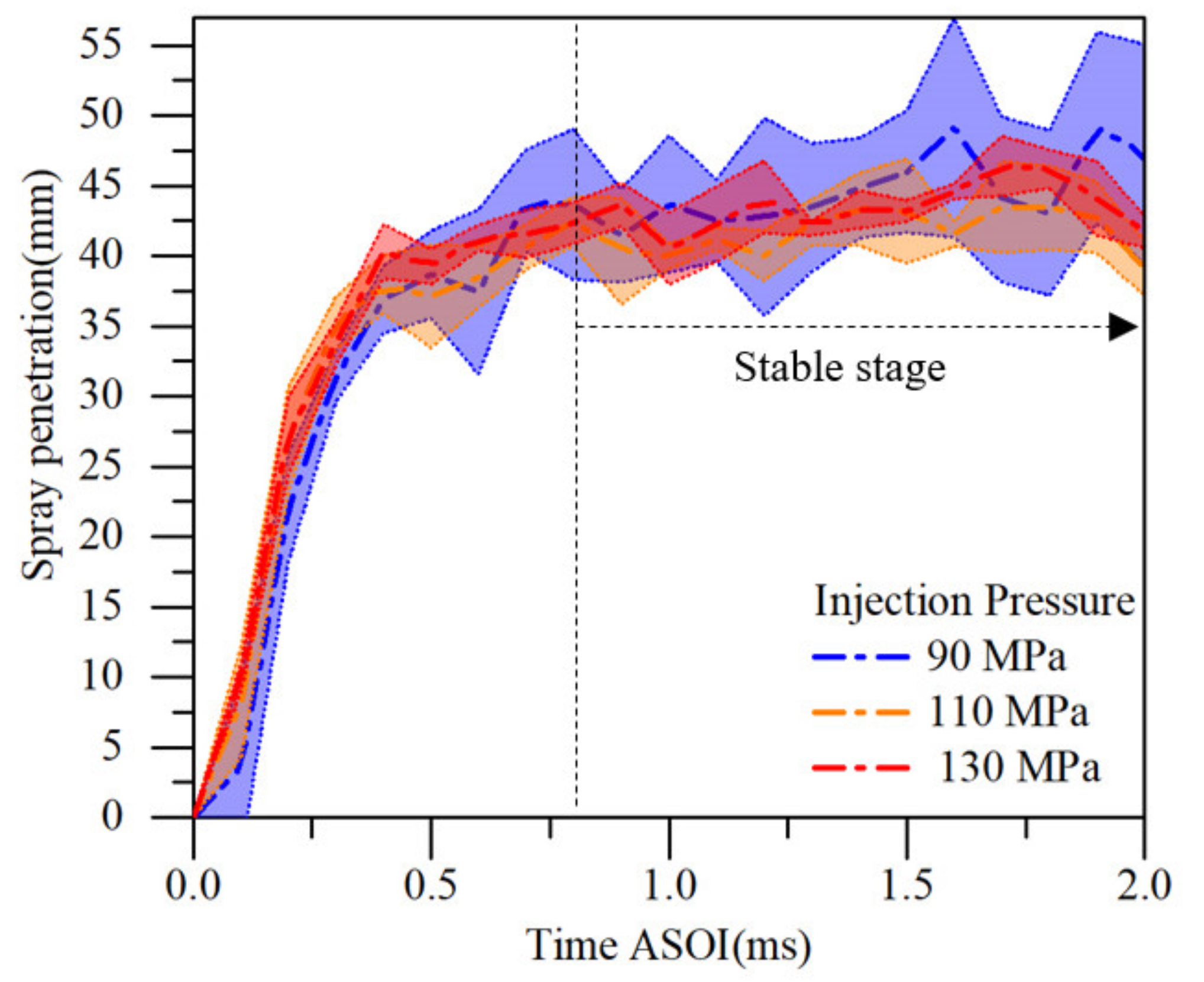



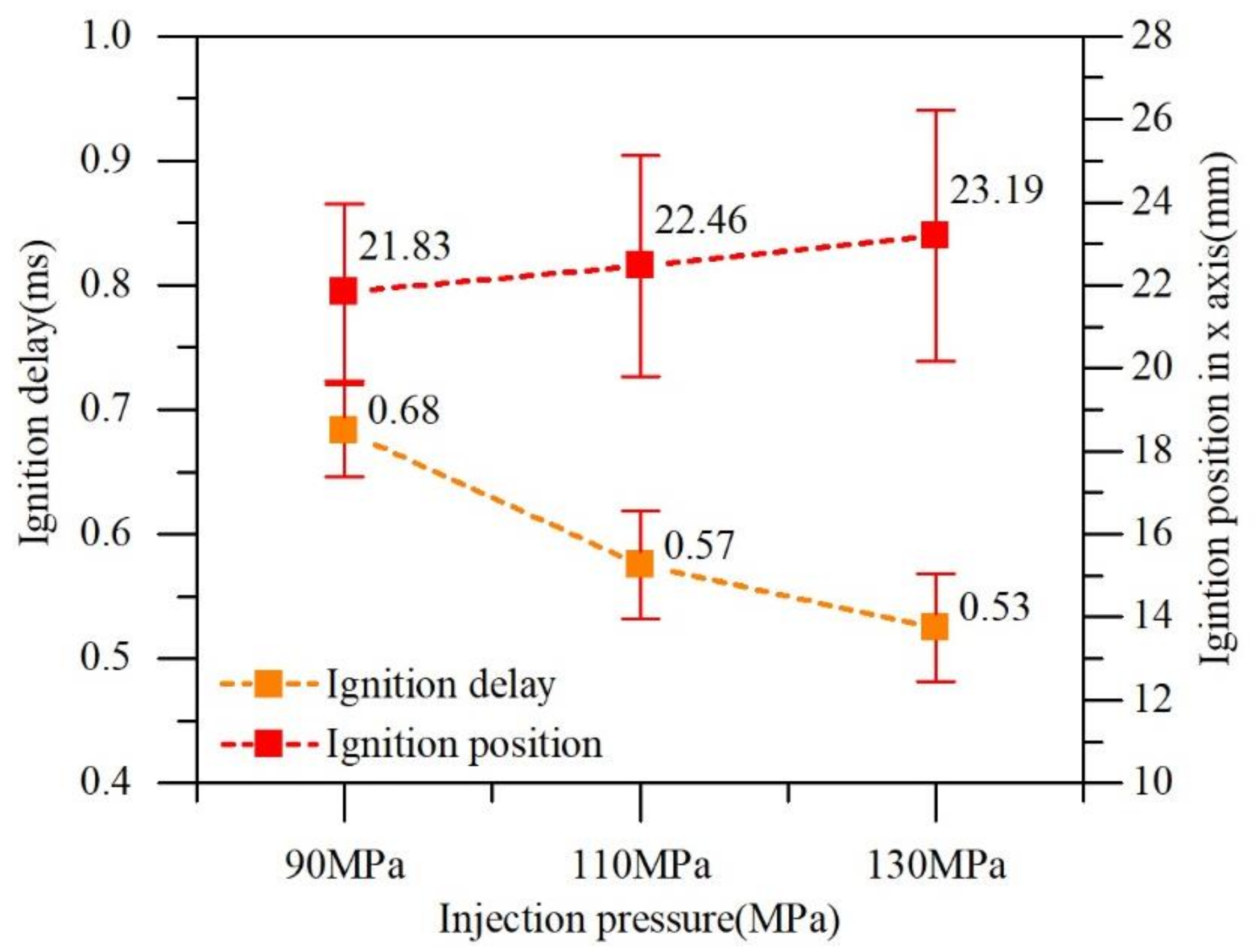
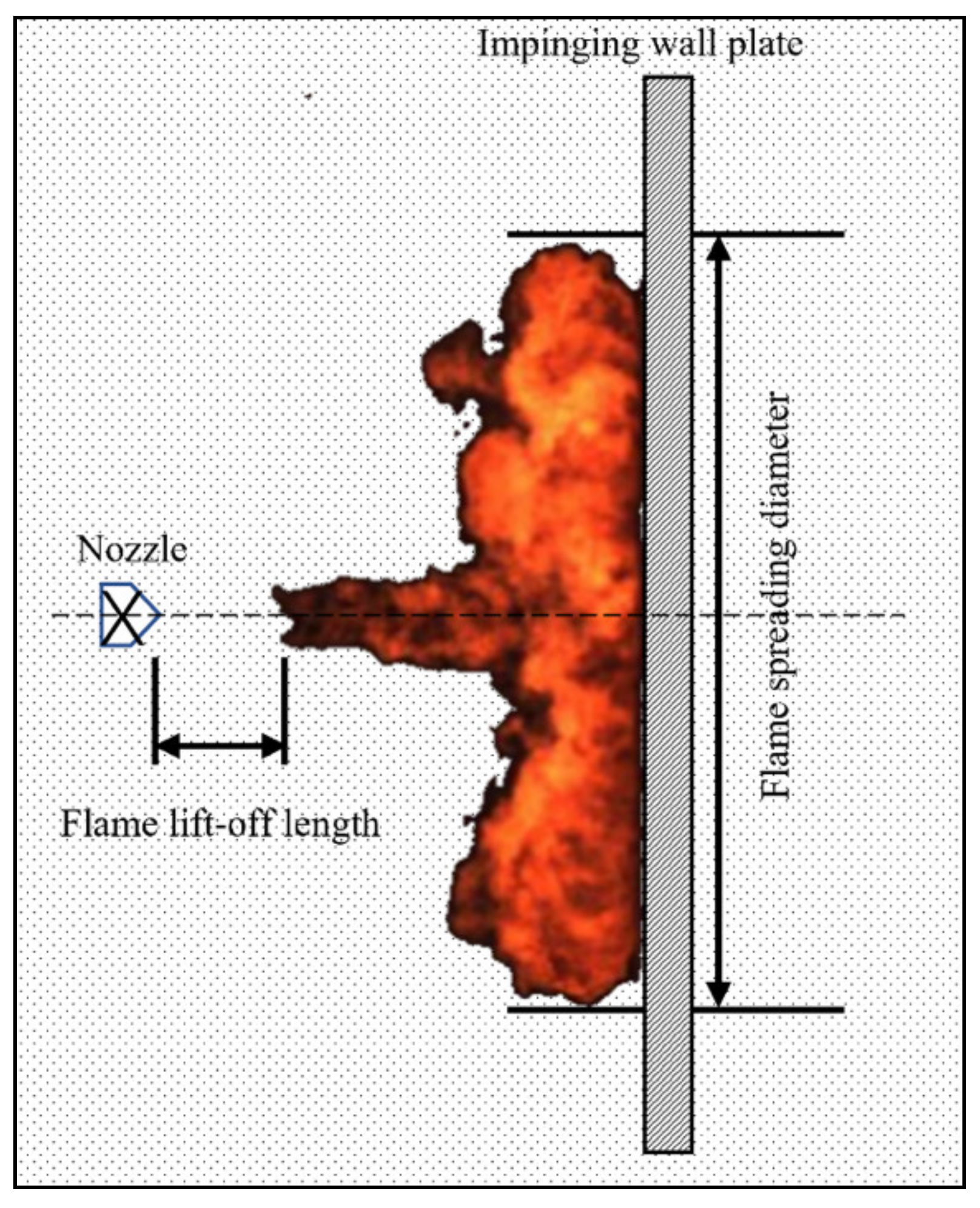
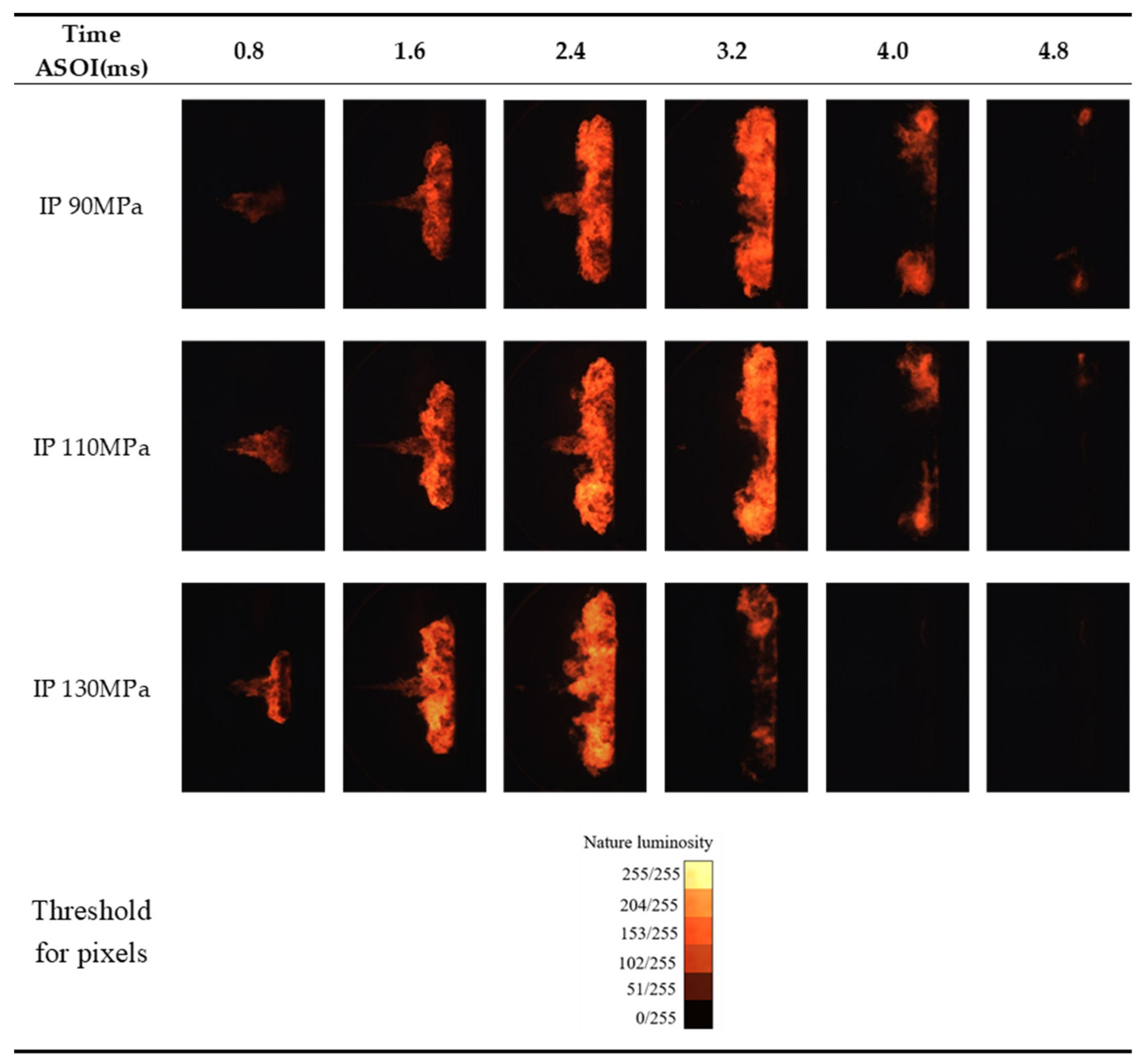
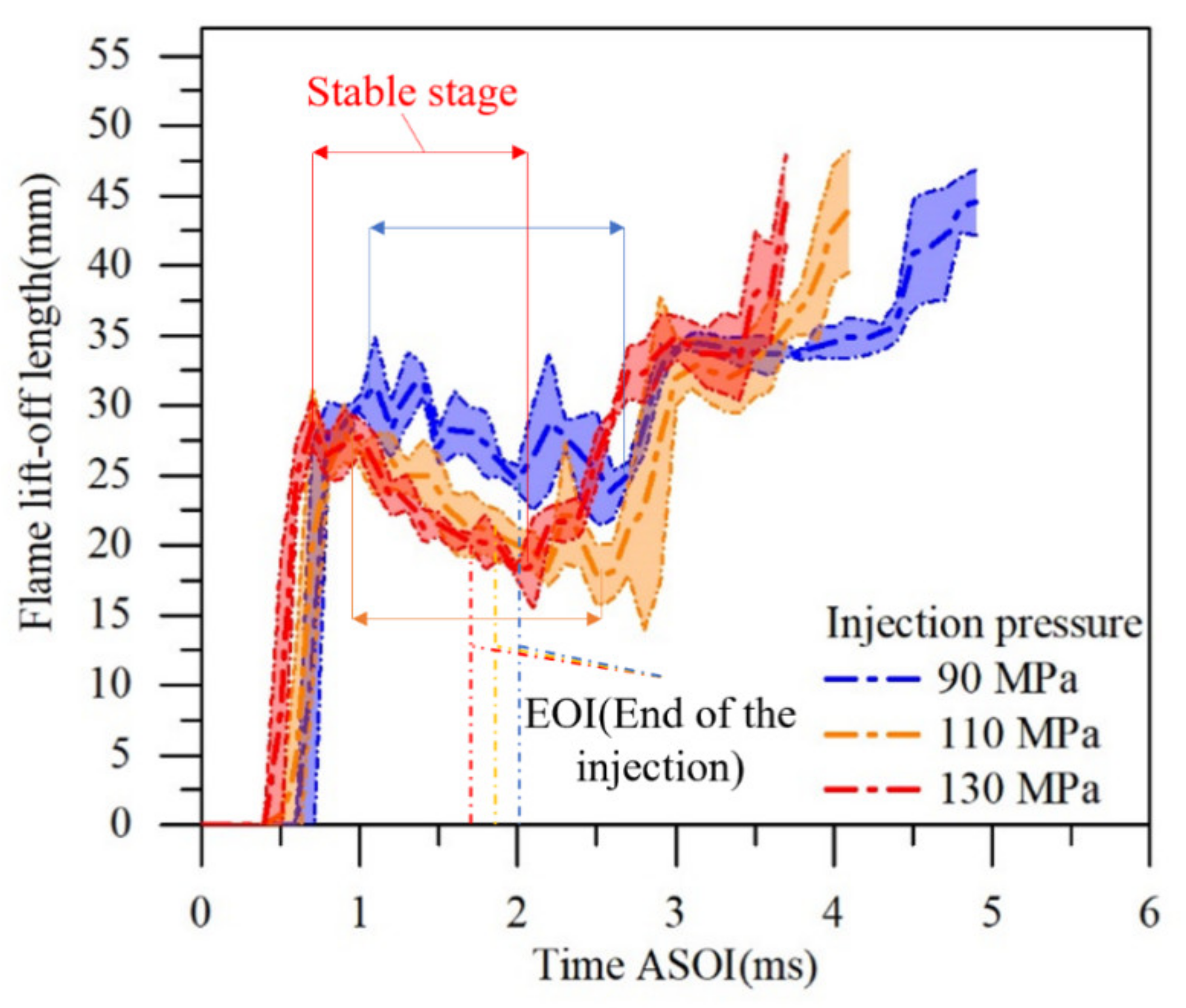

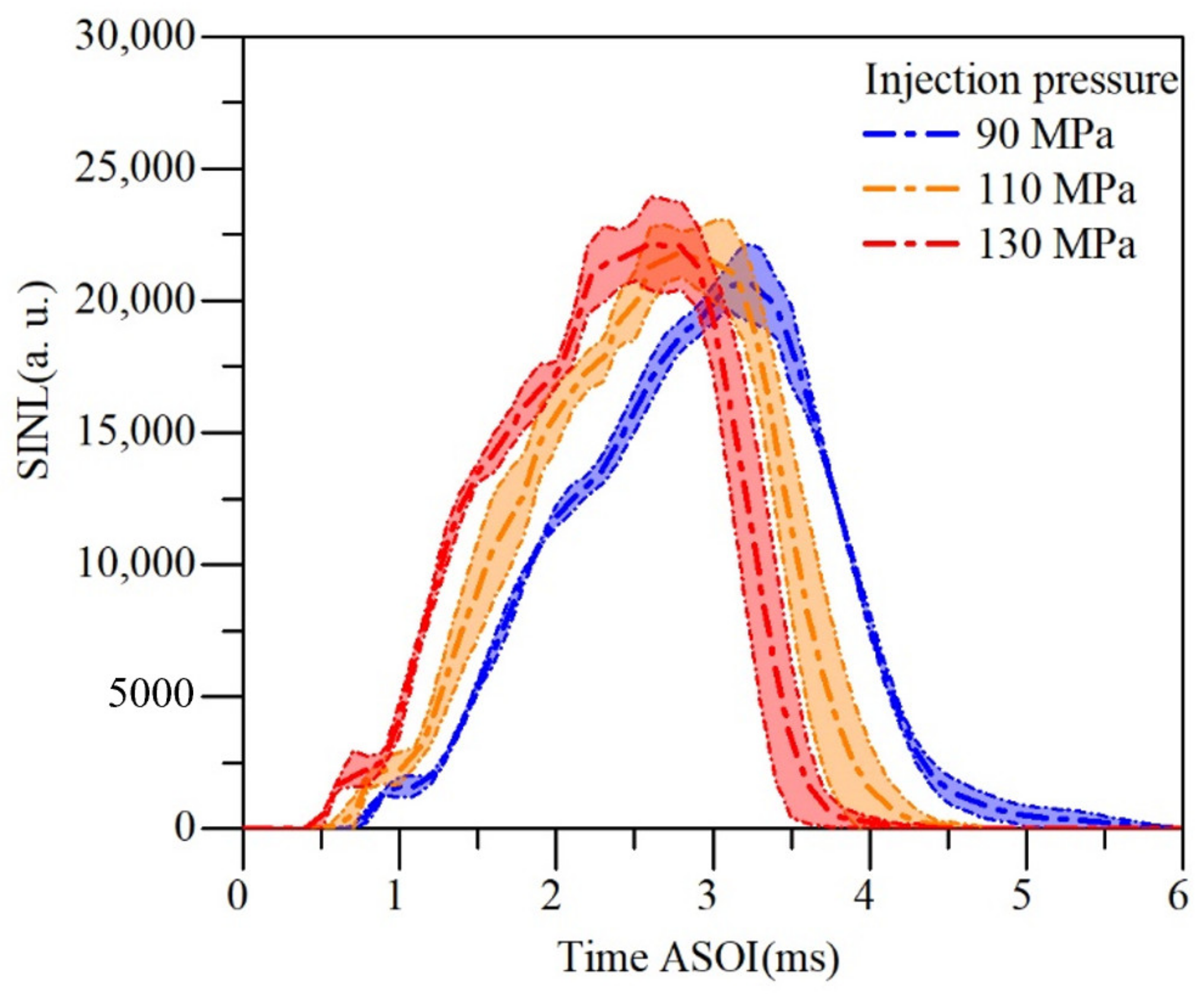

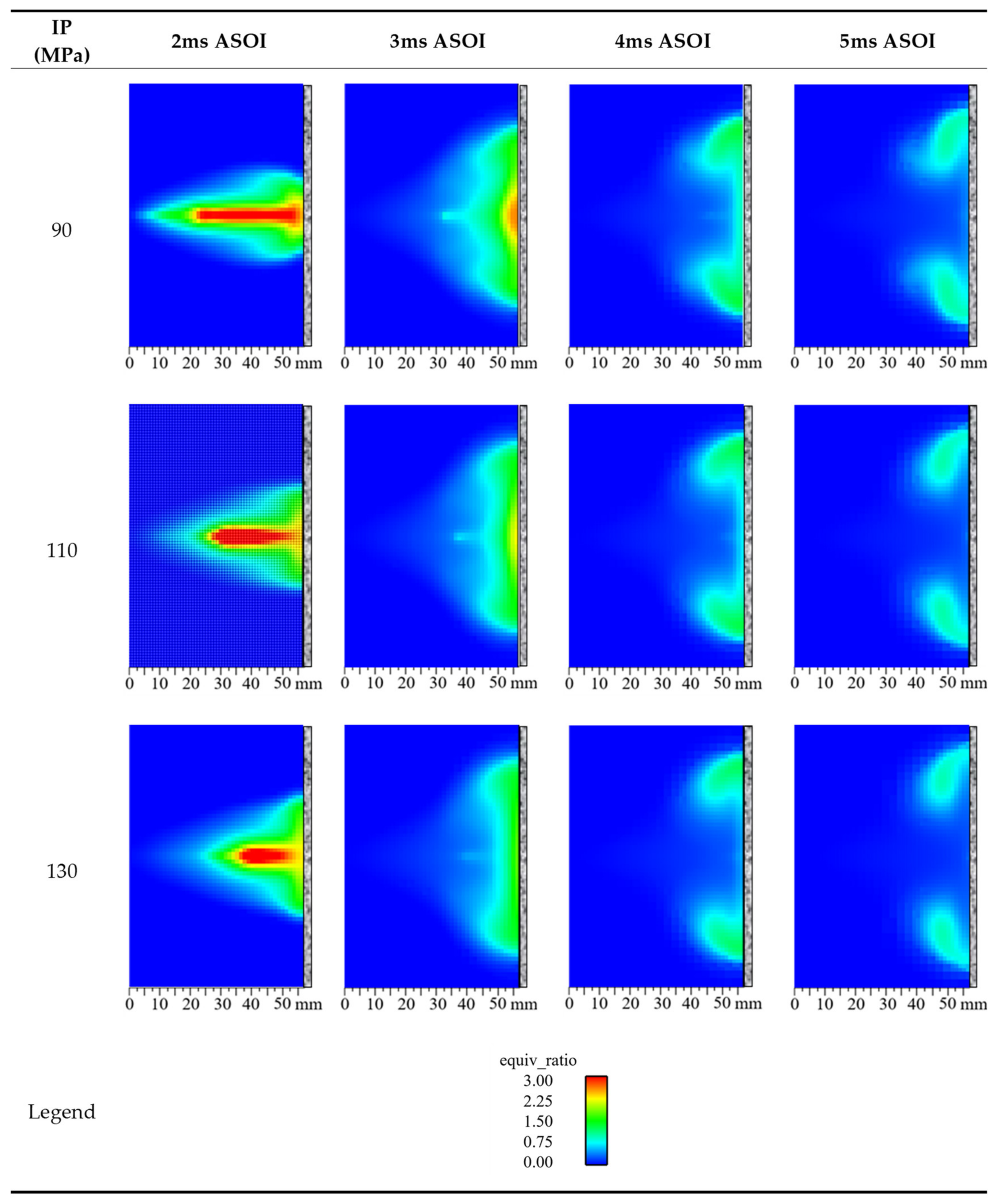

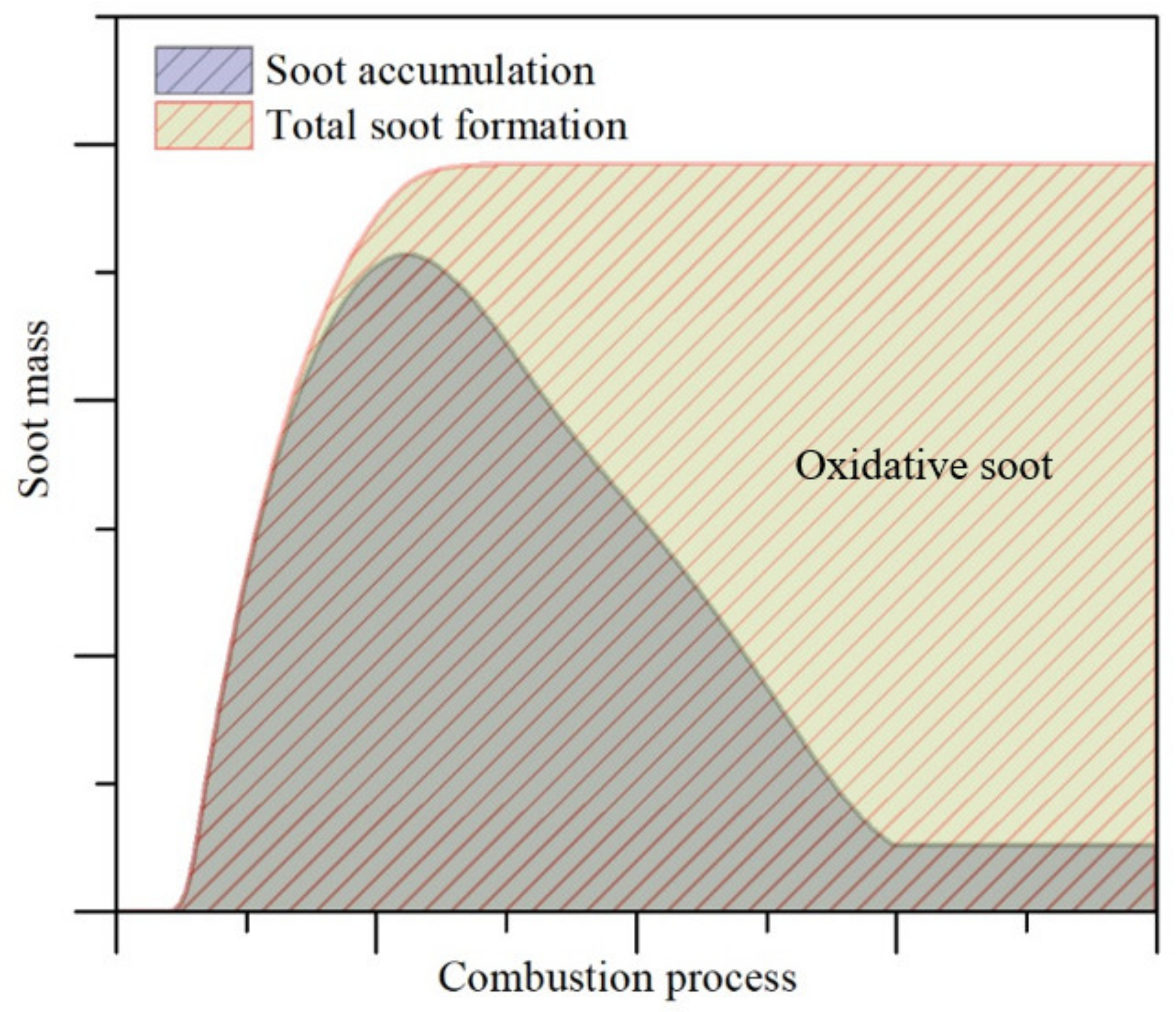
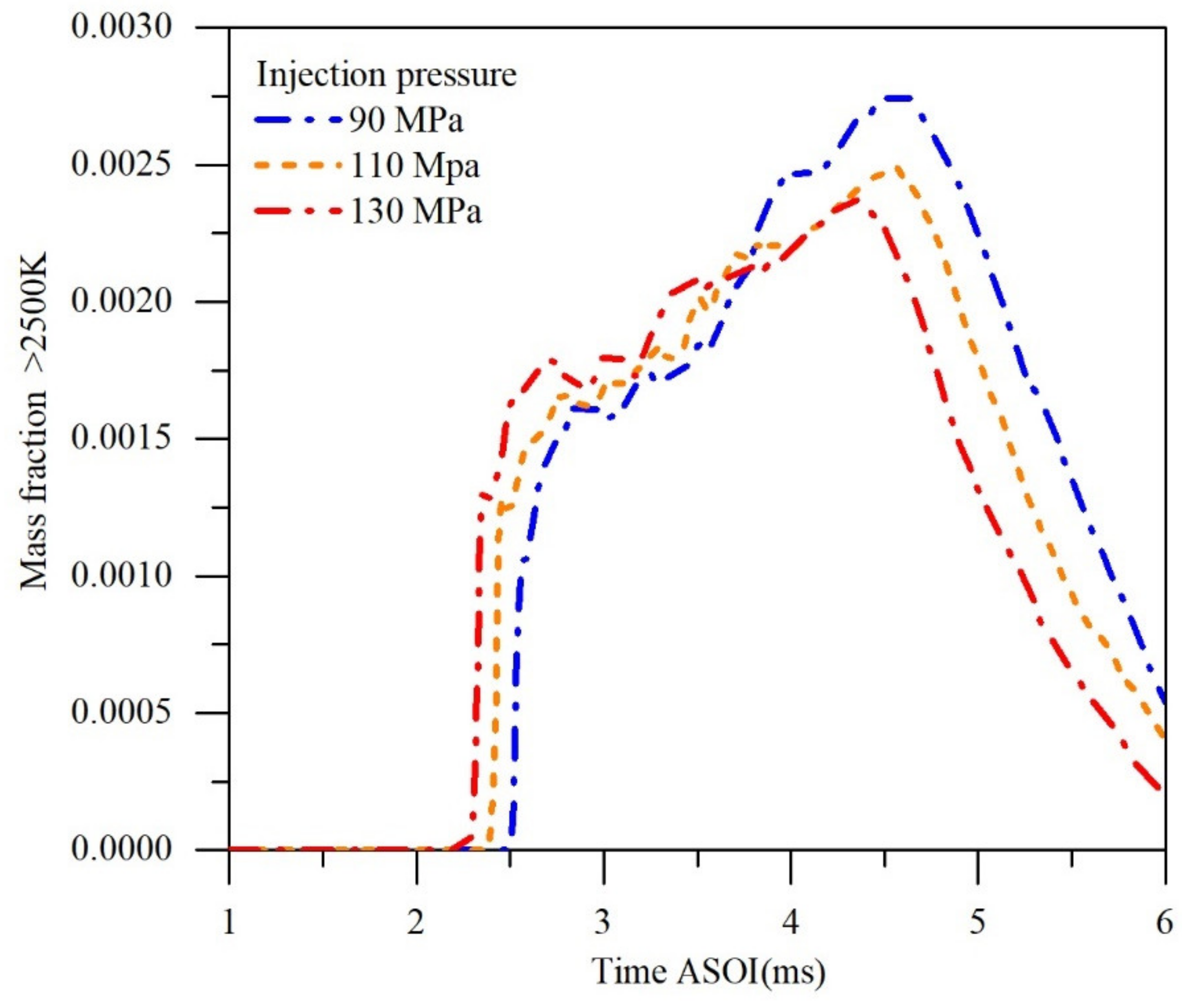
| Setup and Parameters | Spray | Ignition | Flame |
|---|---|---|---|
| Optical layout | LED backlight scattering imaging | Wide area low-pass chemiluminescence imaging | Reduced light direct imaging |
| Filter | / | 600 nm filter | ND8 filter |
| Camera frame rate (fps) | 10,000 | 10,000 | 10,000 |
| time of exposure (μs) | 20 | 54 | 4 |
| Image resolution | 576 × 648 | 576 × 648 | 576 × 648 |
| Spatial resolution (μm/pixel) | 180 | 180 | 180 |
| Items | Value | ||
|---|---|---|---|
| Impinging distance (mm) | 57 | ||
| Ambient temperature (K) | 800 | ||
| Pressure (MPa) | 3.69 | ||
| Ambient density (kg/m3) | 16.07 | ||
| Nozzle orifice diameter (mm) | 0.31 | ||
| Injection mass (mg) | 23 | ||
| Injection pressure (MPa) | 90 | 110 | 130 |
| Parameters | Value |
|---|---|
| Initial regional pressure (Pa) | 369,000 |
| Initial region regional temperature (K) | 800 |
| Nozzle discharge coefficient | 0.54 |
| TKE constant | 3000 |
| Constant turbulent dissipation | 300 |
| KH breakup velocity constant | 0.2 |
| KH breakup time constant | 5.0 |
| RT model size constant | 1.0 |
Publisher’s Note: MDPI stays neutral with regard to jurisdictional claims in published maps and institutional affiliations. |
© 2020 by the authors. Licensee MDPI, Basel, Switzerland. This article is an open access article distributed under the terms and conditions of the Creative Commons Attribution (CC BY) license (http://creativecommons.org/licenses/by/4.0/).
Share and Cite
Tang, Y.; Lou, D.; Wang, C.; Tan, P.; Hu, Z.; Zhang, Y.; Fang, L. Joint Study of Impingement Combustion Simulation and Diesel Visualization Experiment of Variable Injection Pressure in Constant Volume Vessel. Energies 2020, 13, 6210. https://doi.org/10.3390/en13236210
Tang Y, Lou D, Wang C, Tan P, Hu Z, Zhang Y, Fang L. Joint Study of Impingement Combustion Simulation and Diesel Visualization Experiment of Variable Injection Pressure in Constant Volume Vessel. Energies. 2020; 13(23):6210. https://doi.org/10.3390/en13236210
Chicago/Turabian StyleTang, Yuanzhi, Diming Lou, Chengguan Wang, Piqiang Tan, Zhiyuan Hu, Yunhua Zhang, and Liang Fang. 2020. "Joint Study of Impingement Combustion Simulation and Diesel Visualization Experiment of Variable Injection Pressure in Constant Volume Vessel" Energies 13, no. 23: 6210. https://doi.org/10.3390/en13236210





